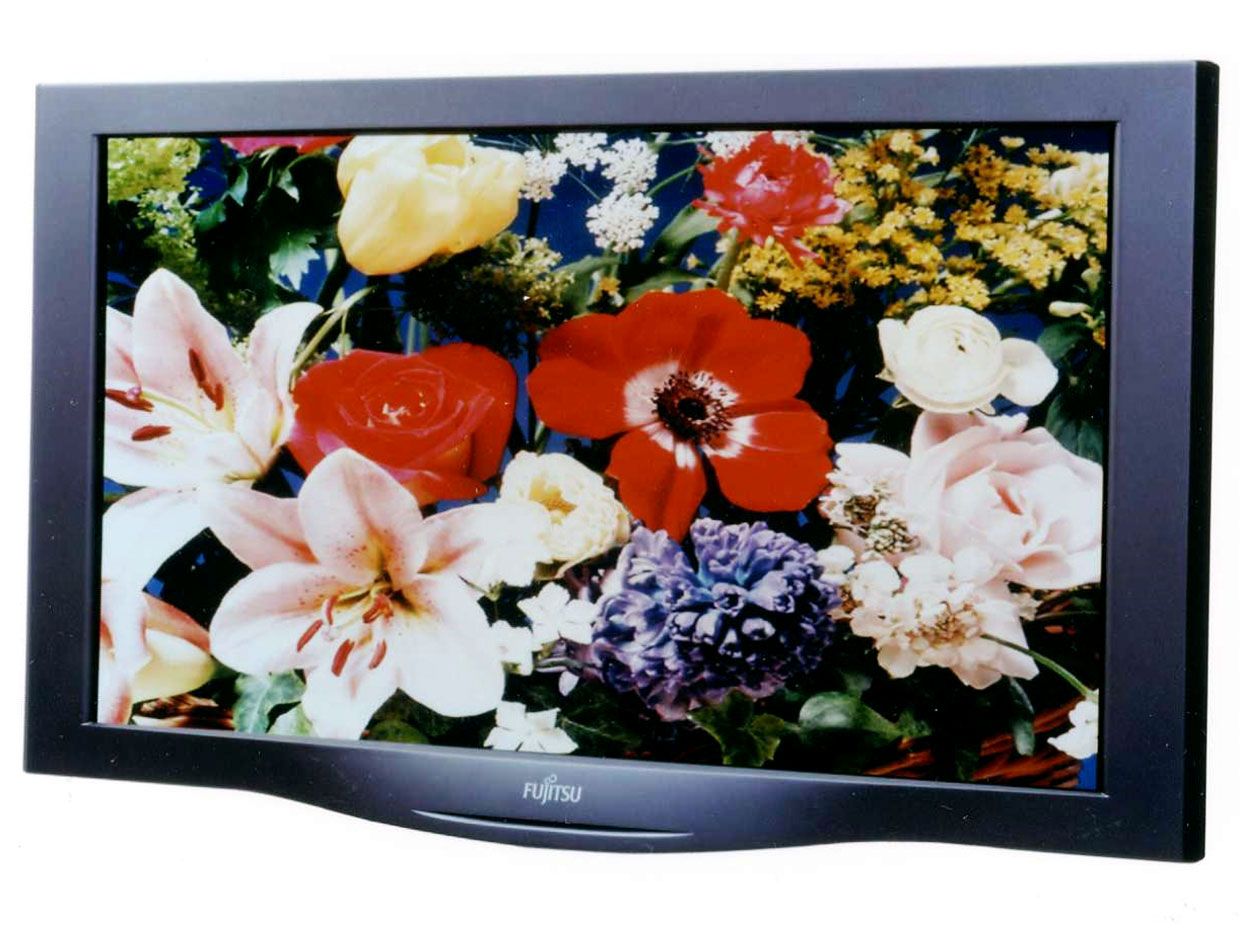The Consumer Electronics Hall of Fame: Fujitsu Plasma TV
 Photo: Fujitsu Hot Stuff: The era of flat-screen televisions began in 1997, when Fujitsu introduced the first commercial full-color plasma display. The screen measured 42 inches diagonally.
Photo: Fujitsu Hot Stuff: The era of flat-screen televisions began in 1997, when Fujitsu introduced the first commercial full-color plasma display. The screen measured 42 inches diagonally.  Enter Here < Back to Consumer Electronics Hall of Fame
Enter Here < Back to Consumer Electronics Hall of Fame Fujitsu's flat-screen plasma television, introduced in 1997, was literally a promise out of science fiction. At about 3 inches thick (75 millimeters), it was as thin as anyone then could hope for. It weighed a trifling 40 pounds (18 kilograms). With a screen that measured 42 inches diagonally, it was about as big as a TV could be in those days.
In short, it was the first large, flat TV that could be mounted to a wall. And to understand why this was such a big deal, you need to go back to "Star Trek." Not the endless movies and sequels but the original TV series. If you are old enough to have watched "Star Trek" in 1966, more likely than not it was on a black-and-white set with a screen measuring no more than 21 inches diagonally. All TVs at the time-B&W or color, and regardless of the size-were built around a heavy cathode-ray tube (CRT) mounted inside a massive cabinet that was sturdy by necessity. CRT TVs weren't just displays, they were furniture. That's why of all the amazing technologies on "Star Trek"-tricorders, warp drives, doors that shooshed open-none announced that "THIS IS THE FUTURE" more than the view screen on the bridge of the USS Enterprise. It was huge. Even more futuristic, it was flat-and mounted to the bulkhead!
Even in the late 1990s, the vast majority of TVs sold were still based on CRTs. But the introduction of high-definition television in the United States in 1998 launched the industry on a trajectory of ever-larger screens, on which viewers could actually see the high definition. Prior to flat-screen TVs, the largest commercially available sets had screens measuring 36 to 43 inches and could weigh more than 100 kg, which was just absurd. That trend couldn't go on. The only thing preventing the death of CRTs was the lack of a better alternative.
Consumer electronics companies were busy pursuing several promising technologies for large, thin screens. Some were experimenting with liquid crystal displays, of which there were several different types. Liquid crystal displays were as thin as could be desired, but through much of the 1990s, developers were still finding it exceedingly difficult to scale LCDs up to a size suitable for anything larger than laptop screens.
The other major flat-screen possibility was the plasma-display panel (PDP). PDPs started out with a humble 1960 research project at the University of Illinois. Over the years, IBM, Corning, NHK, Mitsubishi Electric Corp., Bell Laboratories, Fujitsu and others contributed to the development of the technology. Those early PDPs were all monochrome, and small-useful only as small faceplate displays on various gadgets.
PDPs have a multilayer construction, with layers for dielectrics, electrodes, and so on. The layer distinctive to PDPs included hundreds of thousands (and eventually millions) of separate tiny rectangular chambers, or cells, lined up in rows and columns. In a monochrome PDP, each of these cells represented a single picture element (pixel).
Every cell was filled with a noble gas, typically neon, and also mercury vapor. Every cell had a phosphor dot. Every cell could be individually selected and electrically stimulated. Doing so triggered a series of processes that ionized the atoms of the neon, turning it into a plasma. The plasma emitted electrons, the electrons interacted with the phosphor, and the phosphor emitted light. Collectively, the cells displayed images.
Fujitsu created the first three-electrode cell in 1984, an important prerequisite for practical full-color PDPs. The idea was to put three phosphors in each cell-one each for red, green, and blue (RGB)-and to control them with separate electrodes. Recall that RGB in various combinations can, in theory, produce the gamut of colors visible to the human eye.
It worked, although it took nearly a decade to make it work well. Fujitsu demonstrated its first color plasma display in 1989 and began mass-producing them the following year. Those models produced a limited color palette, however. Instead of RGB, Fujitsu started with red, green, and yellow. In 1992, Fujitsu produced a 21-inch display it claimed was the world's first full-color plasma display.
Just three years later, in 1995, Fujitsu announced the world's first 42-inch color plasma TV, according to PDP technology pioneer Larry Weber. It was another two years before the company publicly announced it would begin mass-producing 42-inch color plasma TVs for commercial sale.
Thirty years after "Star Trek" promised big flat-screen TVs, Fujitsu was boldly going where no TV company had gone before.
Sources differ on the original list price in the United States: It was either $17,500 or $20,000. The disparity might have its roots in a licensing deal that is now obscure because the licenser long ago ceased to exist. Fujitsu had licensed a California-based reseller called QFTV to market TVs that incorporated Fujitsu's plasma display. (Some contemporary sources referred to the product as the Fujitsu QFTV.)
Sony, Panasonic (Matsushita), and NEC were all also developing plasma TVs, with technical variations among them, but none of these companies thought there would be much of a market at those prices. Indeed, Fujitsu's plan was to target those first 42-inch plasma TVs at the corporate market, potentially for teleconferencing or trade-show exhibits, according to a contemporary account in the San Francisco Business Journal (now the San Francisco Business Times).
Not surprisingly, that 1997 model was not a commercial success. But as more television manufacturers entered the market and PDP production volumes ramped up, the price did come down. By 2005, Toshiba Corp. was selling a 42-inch plasma TV for $4,500.
It turned out that PDP technology scaled well. By 2006, 80-inch PDP models were on the market. That same year, Panasonic demonstrated a 103-inch prototype (Samsung had demonstrated a 102-inch prototype the year before). By this time, CRTs were starting to become scarce in stores. Their manufacturers simply couldn't keep up with the increasing size and decreasing price of flat-screen TVs.
But the reign of plasma would be short. All along, TV manufacturers had continued to experiment with LCD technology, because if they could master the manufacturing process, LCD TVs would be lighter, thinner, and even less expensive to produce than PDPs. In the early 2000s, several companies did in fact begin to master the LCD manufacturing process. As LCDs were introduced, they began taking market share from more expensive PDP displays, one larger screen size after another. By 2006, LCDs had taken over the market for TVs measuring 42 inches and under (the best-selling size at the time was 42 inches). Not long after that, LCDs eclipsed PDPs in terms of total sales.
Starting in the late 2000s, yet another display technology began to mature: organic light-emitting diodes. OLED technology also became somewhat less expensive to produce than plasma displays and now roughly matches LCDs for size. Together, LCDs and OLEDs muscled plasma displays completely out of the market. The last two major manufacturers of plasma screen TVs, LG and Samsung, both ceased production in 2014.
And Fujitsu? It announced it would exit the plasma-display business at the end of 2007, a scant decade after establishing it. Recently, in response to a reporter's inquiry, a spokesman for Fujitsu General America, the Fujitsu subsidiary that marketed the TVs in the United States, said the company could no longer find anyone on its payroll who had worked on its plasma TVs.
Back to Consumer Electronics Hall of Fame >> < Back to Consumer Electronics Hall of Fame